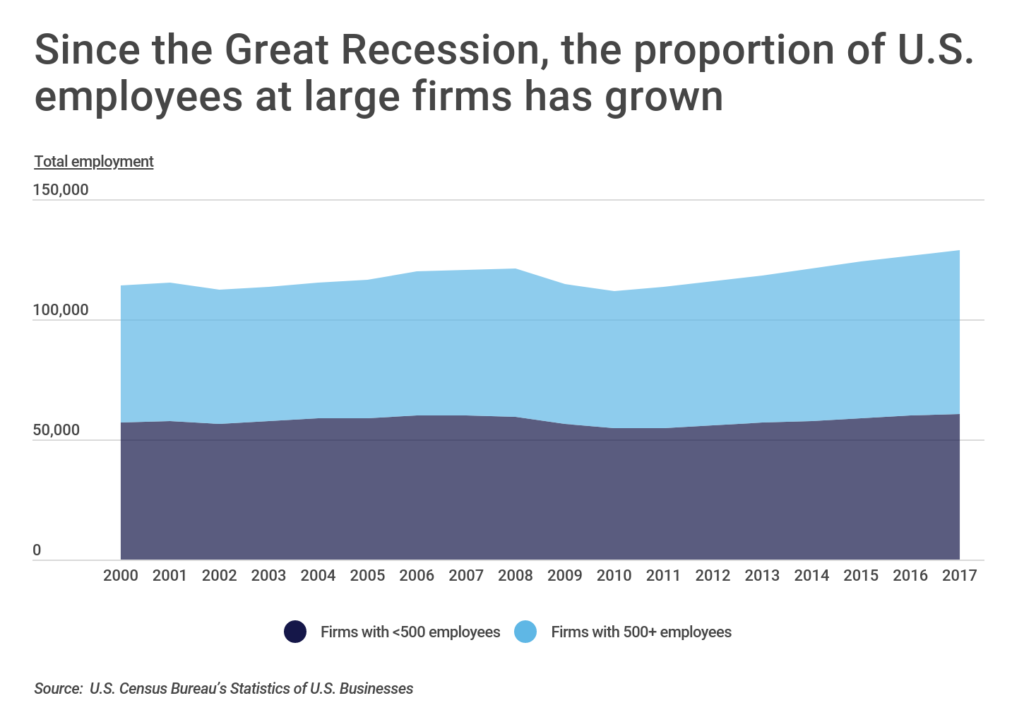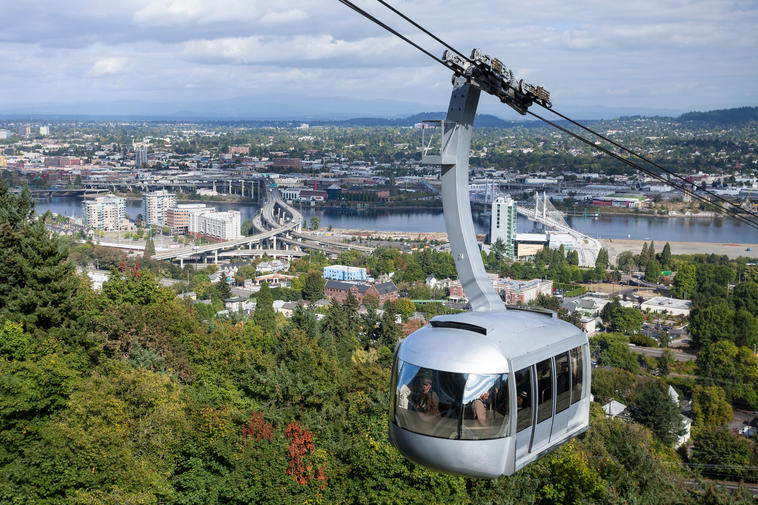Cities Most Dependent on Small Businesses
Small business is often held up as a key driver of the U.S. economy, and for good reason.
According to the U.S. Small Business Administration, small businesses account for 64 percent of net private-sector jobs created since 2005. Collectively, small enterprises employ around 60 million Americans, which represents nearly half of the private workforce in the U.S. Compared to larger firms, small businesses tend to be more nimble, which promotes competition and innovation in the economy. Additionally, small businesses help strengthen communities, and entrepreneurship is a common route through which immigrants assimilate into the social and economic life of the U.S.
But with fewer financial resources than larger firms, small businesses are especially vulnerable during economic downturns. Where large firms can more easily turn to banks or capital markets for an infusion of funding in tough times, small enterprises are more likely to respond by scaling back operations, letting go of employees, or closing altogether.

While the recession of 2008 and the slow recovery that followed were hard on all sectors of the economy, small businesses struggled even more than large firms. Thousands of small businesses failed in the wake of the recession. Many would-be small business owners decided not to take on the financial risk of starting a business during the weak economic recovery, and lenders proved more risk-averse in financing new businesses as well. As a result, industry concentration in large firms has increased over the last decade, and employment growth at large businesses has far outpaced that of small businesses over the same period.

Today, COVID-19 is creating more difficulties for small businesses. Some of the industry sectors that tend to be most densely populated with small firms have also been the sectors most affected by shifts in consumer behavior and government restrictions meant to slow the spread of the virus. Notably, accommodation, food services, and retail businesses together employ nearly a quarter of all small business employees. But with more people staying at home, these firms—many of which have already been forced to close—face dire circumstances.

FOR CONSTRUCTION PROFESSIONALS
Do you operate a small construction business? Before beginning your next project, make sure you have adequate insurance to protect your workers, your vehicles, and your job site. To help, our researchers have found the best builders risk insurance, truck insurance, and workers compensation insurance companies for small businesses.
The continued success of small business matters more for some locations than others. Rural states in the Upper Plains, like Wyoming and Montana, and in New England, like Vermont, have a much higher share of small business employees in the workforce than other states. Because these areas tend to have few large employers, failures in the small business sector could create job shortages and prolonged economic hardship in these areas.
At the metro level, some of the areas most dependent on small businesses are in the aforementioned rural states, but other factors are at play as well. Some are Rust Belt communities where employment was formerly dominated by now-offshored manufacturing operations, leaving smaller businesses to generate most of the economic activity. Others have strong startup ecosystems that encourage entrepreneurs to create new firms. Many of these areas also have high populations of immigrants and racial minorities, who may open up small operations to serve their neighborhoods and immediate social networks.
To identify the locations most dependent on small businesses, researchers at Construction Coverage used U.S. Census data to find the percentage of employees in each metro employed at small businesses, defined as those firms having fewer than 500 employees.
Here are the U.S. metropolitan areas most dependent on small businesses.

Large Metros With the Most Small Business Employment

Photo Credit: Alamy Stock Photo
15. Baltimore-Columbia-Towson, MD
- Percentage of employees at small businesses: 48.53%
- Total number of small business employees: 573,447
- Total number of small businesses: 52,387
- Percentage of total payroll paid by small businesses: 42.56%
- Total small business payroll per employee: $48,700
- Total large-firm payroll per employee: $61,994

Photo Credit: Alamy Stock Photo
14. Austin-Round Rock, TX
- Percentage of employees at small businesses: 49.39%
- Total number of small business employees: 413,394
- Total number of small businesses: 40,661
- Percentage of total payroll paid by small businesses: 42.47%
- Total small business payroll per employee: $48,145
- Total large-firm payroll per employee: $63,651
TRENDING
Do you run a construction business? Make sure you have one of the best construction management software products, as well as takeoff software and estimating software.

Photo Credit: Alamy Stock Photo
13. Sacramento–Roseville–Arden-Arcade, CA
- Percentage of employees at small businesses: 49.45%
- Total number of small business employees: 367,438
- Total number of small businesses: 38,300
- Percentage of total payroll paid by small businesses: 41.78%
- Total small business payroll per employee: $45,280
- Total large-firm payroll per employee: $61,702

Photo Credit: Alamy Stock Photo
12. Washington-Arlington-Alexandria, DC-VA-MD-WV
- Percentage of employees at small businesses: 49.64%
- Total number of small business employees: 1,327,443
- Total number of small businesses: 116,882
- Percentage of total payroll paid by small businesses: 45.11%
- Total small business payroll per employee: $60,027
- Total large-firm payroll per employee: $71,999

Photo Credit: Alamy Stock Photo
11. San Diego-Carlsbad, CA
- Percentage of employees at small businesses: 50.06%
- Total number of small business employees: 634,069
- Total number of small businesses: 69,216
- Percentage of total payroll paid by small businesses: 42.59%
- Total small business payroll per employee: $49,023
- Total large-firm payroll per employee: $66,233

Photo Credit: Alamy Stock Photo
10. San Francisco-Oakland-Hayward, CA
- Percentage of employees at small businesses: 50.31%
- Total number of small business employees: 1,090,428
- Total number of small businesses: 104,849
- Percentage of total payroll paid by small businesses: 37.81%
- Total small business payroll per employee: $67,798
- Total large-firm payroll per employee: $112,911
FOR SMALL BUSINESS OWNERS
Do you regularly use your vehicle for business? If so, you might need a commercial vehicle insurance policy. Our recently update guide on commercial car insurance has everything you need to know.

Photo Credit: Alamy Stock Photo
9. Grand Rapids-Wyoming, MI
- Percentage of employees at small businesses: 50.36%
- Total number of small business employees: 253,133
- Total number of small businesses: 19,092
- Percentage of total payroll paid by small businesses: 48.50%
- Total small business payroll per employee: $43,895
- Total large-firm payroll per employee: $47,283

Photo Credit: Alamy Stock Photo
8. Buffalo-Cheektowaga-Niagara Falls, NY
- Percentage of employees at small businesses: 50.93%
- Total number of small business employees: 245,969
- Total number of small businesses: 21,132
- Percentage of total payroll paid by small businesses: 46.54%
- Total small business payroll per employee: $40,162
- Total large-firm payroll per employee: $47,880

Photo Credit: Alamy Stock Photo
7. Portland-Vancouver-Hillsboro, OR-WA
- Percentage of employees at small businesses: 51.41%
- Total number of small business employees: 538,511
- Total number of small businesses: 55,667
- Percentage of total payroll paid by small businesses: 41.79%
- Total small business payroll per employee: $45,280
- Total large-firm payroll per employee: $66,725

Photo Credit: Alamy Stock Photo
6. Los Angeles-Long Beach-Anaheim, CA
- Percentage of employees at small businesses: 51.93%
- Total number of small business employees: 2,764,749
- Total number of small businesses: 313,657
- Percentage of total payroll paid by small businesses: 46.12%
- Total small business payroll per employee: $52,115
- Total large-firm payroll per employee: $65,764

Photo Credit: Alamy Stock Photo
5. New York-Newark-Jersey City, NY-NJ-PA
- Percentage of employees at small businesses: 51.98%
- Total number of small business employees: 4,356,853
- Total number of small businesses: 499,998
- Percentage of total payroll paid by small businesses: 41.10%
- Total small business payroll per employee: $56,279
- Total large-firm payroll per employee: $87,294

Photo Credit: Alamy Stock Photo
4. Providence-Warwick, RI-MA
- Percentage of employees at small businesses: 52.36%
- Total number of small business employees: 333,667
- Total number of small businesses: 33,162
- Percentage of total payroll paid by small businesses: 47.72%
- Total small business payroll per employee: $43,098
- Total large-firm payroll per employee: $51,898

Photo Credit: Alamy Stock Photo
3. Oklahoma City, OK
- Percentage of employees at small businesses: 53.32%
- Total number of small business employees: 269,939
- Total number of small businesses: 28,210
- Percentage of total payroll paid by small businesses: 48.62%
- Total small business payroll per employee: $40,574
- Total large-firm payroll per employee: $48,974

Photo Credit: Alamy Stock Photo
2. Miami-Fort Lauderdale-West Palm Beach, FL
- Percentage of employees at small businesses: 53.50%
- Total number of small business employees: 1,184,791
- Total number of small businesses: 167,326
- Percentage of total payroll paid by small businesses: 48.27%
- Total small business payroll per employee: $43,392
- Total large-firm payroll per employee: $53,498

Photo Credit: Alamy Stock Photo
1. New Orleans-Metairie, LA
- Percentage of employees at small businesses: 53.65%
- Total number of small business employees: 265,378
- Total number of small businesses: 23,960
- Percentage of total payroll paid by small businesses: 49.26%
- Total small business payroll per employee: $43,602
- Total large-firm payroll per employee: $51,989
Detailed Findings & Methodology
The data used in this analysis is from the U.S. Census Bureau’s Statistics of U.S. Businesses, which includes all U.S. businesses with paid employees. To identify the locations most dependent on small businesses, researchers calculated the percentage of all employees at small businesses—defined as those firms having fewer than 500 employees. The researchers also calculated the percentage of total payroll accounted for by small-business employees, as well as the average payroll per employee at large and small businesses.
To improve relevance, only metropolitan areas with at least 100,000 residents were included. Additionally, metros were grouped into cohorts based on population size: small (100,000-349,999), midsize (350,000-999,999), and large (1,000,000 or more).
Each company featured in our guides has been independently selected and reviewed by our research team. If you select one of these companies and click on a link, we may earn a commission.
By clicking on these links, you may be taken to one of our insurance partners. The specific company listed here may or may not be included in our partner’s network at this time.
